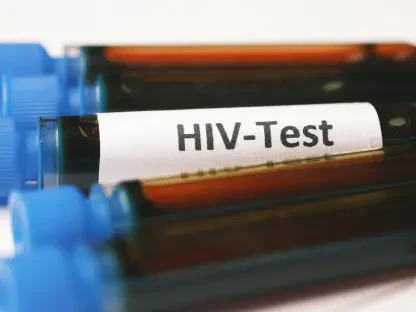Malaria remains a formidable global health crisis, taking an immense toll on lives, especially in Africa where it accounts for approximately 95% of all fatalities from the disease, presenting a particularly insidious challenge in curbing this epidemic through the silent spread of asymptomatic infections. These are cases where individuals harbor the malaria parasite without displaying any outward signs, unknowingly facilitating transmission through mosquito bites. These hidden carriers often escape detection by conventional diagnostic tools, allowing the disease to persist in communities that are already vulnerable. However, a revolutionary advancement in diagnostics promises to change the landscape of malaria control. Known as the Dragonfly test, this rapid point-of-care tool can identify low-level infections in mere minutes, offering a beacon of hope for regions hardest hit by the disease. Developed through an international collaboration, this innovation could redefine strategies to eliminate malaria by targeting those who spread it without even realizing they are infected.
Addressing the Silent Spread of Malaria
Uncovering Hidden Infections
The persistent challenge of asymptomatic malaria infections has long hindered efforts to eradicate the disease, as these cases serve as undetected reservoirs that perpetuate transmission in endemic areas. The Dragonfly test emerges as a critical solution, boasting a sensitivity rate exceeding 95%, which enables it to detect infections even when parasite levels are too low for traditional methods like microscopy to identify. This capability is pivotal in regions where silent carriers contribute significantly to the spread of malaria, often without seeking treatment due to the absence of symptoms. By pinpointing these hidden cases, the test supports test-and-treat initiatives that aim to interrupt the cycle of infection at its source. Such precision in diagnostics is not just a technical achievement but a potential lifeline for communities grappling with the burden of this disease, providing health workers with the means to act swiftly and effectively in areas where every case counts toward elimination goals.
Beyond its technical prowess, the significance of detecting asymptomatic malaria lies in its broader impact on public health strategies across affected regions. The ability of Dragonfly to identify infections that evade standard diagnostics means that health systems can now target individuals who would otherwise remain untreated, continuing to spread the parasite through mosquito vectors. This approach aligns with global efforts to reduce malaria incidence by focusing on comprehensive community screening rather than solely on symptomatic patients. Moreover, the test’s rapid results—delivered in under an hour—ensure that interventions can be implemented without delay, minimizing the window during which transmission can occur. This shift toward proactive identification of all carriers, not just those visibly ill, represents a fundamental change in how malaria control programs operate, particularly in high-burden areas of sub-Saharan Africa where resources for extensive lab-based testing are often scarce.
Enhancing Elimination Strategies
The introduction of Dragonfly into malaria control frameworks offers a transformative opportunity to bolster elimination strategies by addressing the root of sustained transmission. Unlike conventional rapid diagnostic tests that often miss low-density infections, this tool’s advanced sensitivity ensures that even the most elusive cases are caught, allowing for targeted treatment that can significantly curb the spread of the disease. In practical terms, this means health campaigns can move beyond reactive measures—treating only those who present with fever or other symptoms—and adopt a more preventive stance by systematically screening entire populations in at-risk zones. Such a strategy is especially crucial in settings where malaria is seasonal, as identifying carriers during low-transmission periods can prevent outbreaks when conditions become favorable for mosquitoes. The potential to disrupt transmission chains through early detection marks a significant step forward in the global fight against malaria.
Furthermore, the integration of Dragonfly into existing health systems could redefine resource allocation for malaria elimination, prioritizing areas with high rates of asymptomatic infections. By providing accurate data on the true prevalence of the disease, including cases that were previously invisible to health surveillance, this diagnostic tool enables policymakers and health officials to make informed decisions about where to focus interventions. This data-driven approach can optimize the use of limited resources, ensuring that treatments, mosquito control measures, and educational campaigns are deployed where they are most needed. Additionally, the test’s ability to support mass screening efforts fosters community-wide engagement, as it empowers local health teams to address malaria comprehensively rather than piecemeal. This holistic perspective is vital for sustaining progress toward eradication, particularly in regions where the disease remains entrenched despite years of effort.
Accessibility and Scalability for Real-World Impact
Bridging Gaps in Resource-Limited Settings
One of the standout features of the Dragonfly test is its deliberate design for accessibility, tailored to meet the needs of resource-limited environments where malaria takes its heaviest toll. Requiring only a finger-prick blood sample, the test processes results in about 10 minutes, followed by a 30-minute incubation in a portable heater, with outcomes displayed via a simple color chart—pink indicating negative and yellow indicating positive. This visual interpretation eliminates the need for specialized training, enabling community health workers in remote areas to use the tool with confidence. Such ease of use is a game-changer in sub-Saharan Africa, where access to advanced laboratory facilities is often limited, and health infrastructure may be stretched thin. By bringing diagnostics directly to the field, Dragonfly reduces the dependency on centralized testing centers, ensuring that even the most isolated communities can benefit from cutting-edge technology in the fight against malaria.
Equally important is the test’s adaptability to challenging environments, which further cements its role as a practical solution for widespread deployment. Its compact, battery-operated design means it can function without reliable electricity, a common barrier in many rural areas affected by malaria. This portability allows health workers to conduct screenings in villages far from urban centers, reaching populations that are often overlooked by traditional health services. Additionally, the minimal equipment required for operation lowers the logistical hurdles of implementing diagnostic programs in such settings. The focus on user-friendliness and independence from sophisticated infrastructure positions Dragonfly as an essential asset for grassroots health initiatives, where the ability to test and treat on the spot can make a profound difference in curbing the disease’s spread among vulnerable groups who lack access to conventional medical care.
Scaling Up for Broader Reach
Scalability stands as a cornerstone of Dragonfly’s potential to revolutionize malaria diagnostics on a global scale, particularly through its prospects for affordable mass production. The test’s low-cost framework is designed with the economic constraints of high-burden regions in mind, ensuring that it can be rolled out extensively without straining public health budgets. If production costs are kept manageable, as current efforts suggest, this tool could become a staple in national malaria control programs across Africa, where the need for accessible diagnostics is most acute. The vision of equipping countless health workers with an effective, inexpensive test could transform how entire countries approach disease surveillance and treatment, shifting the focus from sporadic interventions to systematic, widespread screening that leaves no case undetected.
Moreover, the potential for local manufacturing partnerships, such as those being explored with the Africa Centers for Disease Control and Prevention, adds another layer of promise to Dragonfly’s scalability. Producing the test within the continent could not only reduce costs associated with importation but also stimulate local economies by creating jobs and building capacity for health technology innovation. This approach would ensure a sustainable supply chain, addressing one of the frequent challenges in deploying medical tools in low-resource settings—availability over the long term. As plans for mass production and distribution take shape, the emphasis on affordability and local engagement will be crucial in making Dragonfly a viable option for governments and organizations aiming to tackle malaria at scale. This strategic focus on both economic and logistical feasibility underscores the test’s potential to reach millions, fundamentally altering the trajectory of malaria control in the most affected regions.
Collaborative Innovation in Global Health
Power of International Partnerships
The development of the Dragonfly test exemplifies the strength of international collaboration in addressing complex global health challenges like malaria. Bringing together expertise from Imperial College London, research units in The Gambia and Burkina Faso, and industry partners such as ProtonDx Ltd, this project harnessed diverse perspectives to create a tool that is both scientifically robust and contextually relevant. Field trials involving nearly 700 blood samples in West African communities validated the test’s accuracy against gold-standard methods like PCR testing, demonstrating its reliability in real-world conditions. This partnership model ensured that the technology was not developed in isolation but was shaped by the needs and insights of the regions it aims to serve, highlighting how global cooperation can lead to meaningful advancements in public health.
Additionally, the inclusion of local expertise in the development and testing phases of Dragonfly has been instrumental in tailoring the tool to the unique challenges faced by endemic areas. Researchers and health workers from The Gambia and Burkina Faso provided critical input on the practicalities of deploying diagnostics in remote settings, ensuring that the test’s design accounts for local realities such as limited infrastructure and varying levels of training among staff. This collaborative approach fosters a sense of ownership among communities and institutions in affected regions, which is essential for the long-term adoption and success of any health intervention. By uniting academic rigor with on-the-ground knowledge, the project sets a powerful example of how cross-border partnerships can drive innovation that resonates with the specific needs of those most impacted by diseases like malaria.
Building Sustainable Health Solutions
The collaborative framework behind Dragonfly also lays the groundwork for sustainable health solutions that extend beyond a single diagnostic tool. By engaging a network of stakeholders—including academic institutions, local research units, and private entities—the project has created a blueprint for how to develop and implement medical technologies in ways that prioritize longevity and impact. This model emphasizes the importance of shared goals and mutual learning, where each partner contributes unique strengths to solve a common problem. Such synergy is particularly vital in global health, where isolated efforts often fall short of addressing systemic issues like disease transmission across borders and diverse populations.
Furthermore, the focus on sustainability through potential local production partnerships reflects a forward-thinking approach to ensuring that innovations like Dragonfly remain accessible over time. Collaborating with regional bodies to manufacture the test within Africa could reduce dependency on external supply chains, making the tool a more integral part of local health systems. This strategy not only addresses immediate diagnostic needs but also builds capacity for future health technology development within the continent. The emphasis on creating enduring solutions through collaboration highlights a shift toward holistic interventions that empower communities to take charge of their health outcomes, setting a precedent for how global health challenges can be met with inclusive, sustainable innovation.
Future Challenges and Opportunities
Navigating Implementation Barriers
As promising as the Dragonfly test appears, its journey from research to widespread use faces several implementation barriers that must be carefully navigated. Currently classified as a research-use-only device, the final manufacturing cost remains undetermined, posing a potential obstacle to affordability in low-resource settings where every dollar counts. Ensuring that the test remains cost-effective for mass deployment will be critical to its adoption by national health programs in malaria-endemic regions. Additionally, maintaining consistent performance across varied environmental conditions—such as extreme heat or humidity common in sub-Saharan Africa—presents another hurdle. Addressing these practical challenges through rigorous field testing and strategic pricing models will be essential to guarantee that the tool fulfills its potential as a cornerstone of malaria control efforts.
Beyond cost and environmental concerns, the integration of Dragonfly into existing health systems requires thoughtful planning to avoid logistical pitfalls. Distribution networks in remote areas often lack the infrastructure needed to deliver medical supplies efficiently, which could delay the test’s reach to the communities that need it most. Moreover, training programs must be scaled to equip health workers with the skills to use and interpret the test accurately, even in settings with high staff turnover. Overcoming these barriers will involve collaboration with local governments and health organizations to build robust support systems around the technology. The focus on solving these implementation challenges underscores the need for a comprehensive approach that goes beyond innovation to ensure that the benefits of Dragonfly are realized in practice, particularly in the regions bearing the heaviest malaria burden.
Charting the Path to Wider Adoption
Looking ahead, the opportunities for Dragonfly to shape malaria elimination are vast, provided upcoming studies confirm its durability in community settings with limited resources. Future evaluations will focus on testing the tool’s resilience under real-world conditions, where factors like inconsistent power supply or lack of technical support could impact performance. These studies will provide critical data on how the test holds up over extended periods of use, informing adjustments to its design or deployment strategies as needed. Successfully demonstrating reliability in diverse environments will be a key step toward gaining approval for broader commercial use, paving the way for integration into national and international health initiatives targeting malaria eradication.
Equally significant is the potential for Dragonfly to inspire similar advancements in diagnostic technology for other neglected tropical diseases prevalent in low-resource areas. Its success could catalyze investment in point-of-care tools that prioritize accessibility and affordability, addressing a range of public health challenges beyond malaria. Furthermore, establishing local manufacturing capabilities in Africa, as discussions with regional health bodies suggest, could enhance access while fostering economic growth and technological independence. This dual benefit—improving health outcomes and building capacity—positions Dragonfly as a model for future innovations. As efforts continue to refine and scale this tool, the focus remains on ensuring it becomes a sustainable, impactful solution in the global fight against malaria, setting a benchmark for how diagnostics can transform disease control in the most affected regions.









